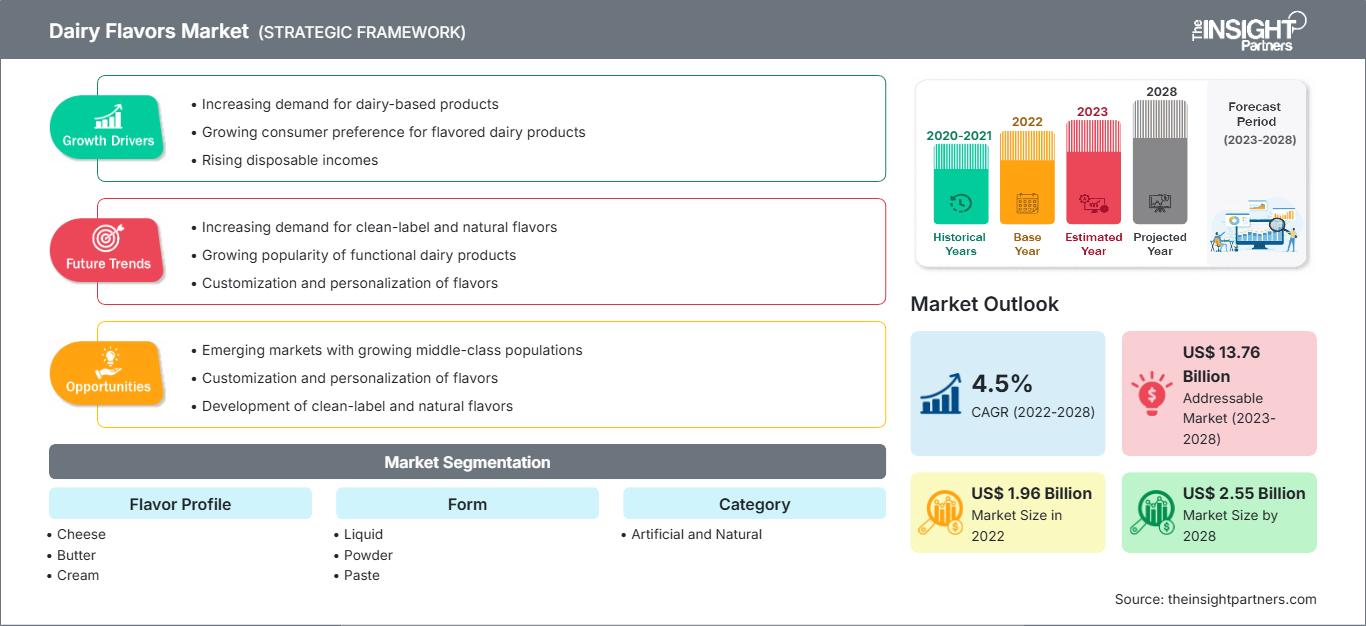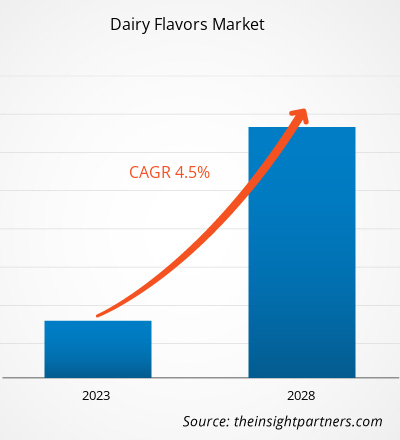Se espera que el tamaño del mercado de sabores lácteos crezca de US$ 1.962,45 millones en 2022 a US$ 2.552,19 millones en 2028; se estima que crecerá a una CAGR del 4,5% entre 2022 y 2028.
Los sabores lácteos son agentes saborizantes añadidos a diversos productos alimenticios y bebidas para impartir el sabor de productos lácteos como mantequilla, queso, crema y leche. Los sabores lácteos están ganando terreno en la industria de alimentos y bebidas, ya que ayudan a impartir sabor lácteo sin agregar a las calorías o contenido de grasa del producto. Los sabores lácteos se procesan y fabrican a partir de productos lácteos como leche, mantequilla, queso y crema y están disponibles en formatos líquido, en polvo y pasta. Estos sabores están destinados a realzar el sabor y la intensidad de diversos productos alimenticios al proporcionarles una gama de perfiles de sabor como mantequilla, queso, cremoso y varios otros sabores dulces y salados. Los sabores lácteos se utilizan en diversos productos alimenticios como panadería y confitería, bocadillos dulces y salados, sopas y salsas, dips y aderezos, y postres congelados.
En 2021, Asia Pacífico concentró la mayor participación en el mercado de sabores lácteos y se estima que registrará la CAGR más alta durante el período de pronósticos. El crecimiento del mercado en esta región se atribuye principalmente a la creciente conciencia sobre la salud y al mayor interés por la comida sabrosa en países como India, China y Japón, debido al aumento de la renta disponible. En estos países, los consumidores están dispuestos a pagar precios más altos por productos lácteos con sabor. India se posiciona como uno de los mercados de mayor crecimiento en Asia Pacífico, donde los consumidores no están dispuestos a sacrificar el sabor ni la salud de los alimentos. Existe una demanda masiva de sabores regionales y tradicionales del subcontinente indio, lo que impulsa el crecimiento del mercado.
Personalice este informe según sus necesidades
Obtendrá personalización en cualquier informe, sin cargo, incluidas partes de este informe o análisis a nivel de país, paquete de datos de Excel, así como también grandes ofertas y descuentos para empresas emergentes y universidades.
Mercado de sabores lácteos: Perspectivas estratégicas

-
Obtenga las principales tendencias clave del mercado de este informe.Esta muestra GRATUITA incluye análisis de datos, desde tendencias del mercado hasta estimaciones y pronósticos.
Impacto de la pandemia de COVID-19 en el mercado de sabores lácteos
Antes de la pandemia, la creciente demanda de alimentos procesados y la creciente demanda de los consumidores de una variedad de sabores fueron factores clave que impulsaron el crecimiento del mercado de sabores lácteos. Este mercado se vio impulsado por la incorporación de una variedad de sabores en los productos por parte de la industria de alimentos y bebidas. Además, la tendencia de los consumidores hacia sabores naturales y el aumento del consumo de productos listos para consumir fueron otros factores que influyeron positivamente en el crecimiento del mercado. Sin embargo, las industrias experimentaron desafíos sin precedentes tras el inicio de la pandemia de COVID-19 en 2020, incluyendo limitaciones en la cadena de suministro causadas por confinamientos nacionales, prohibiciones comerciales y restricciones de viaje. Las interrupciones en la cadena de suministro generaron una escasez de materias primas, lo que afectó la producción y distribución de diversos productos, provocando un aumento de precios.
En 2021, varias economías reanudaron sus operaciones tras el anuncio de los gobiernos de varios países de la flexibilización de las restricciones impuestas previamente, lo que impulsó el mercado global. Además, se permitió a los fabricantes operar a plena capacidad, lo que les ayudó a superar la brecha de oferta y demanda, así como otras repercusiones. Dado que numerosos ciudadanos de muchos países ya estaban completamente vacunados para 2021, los fabricantes de sabores lácteos se centraron en aumentar su producción para reactivar sus negocios.
Perspectivas del mercado
Los desarrollos estratégicos de los actores clave favorecen el crecimiento del mercado de sabores lácteos
En junio de 2020, Edlong amplió su segmento de sabores naturales a base de lácteos con la inclusión de una línea de quesos de alta intensidad y perfiles cultivados para su uso en salsas, aderezos y dips. En mayo de 2021, Synergy Flavors adquirió Innova Flavors de Griffith Foods Worldwide. Esta adquisición ofrece importantes beneficios a los clientes de Synergy, brindándoles acceso a una variedad probada de sabores para satisfacer la creciente demanda de sabores naturales e ingredientes salados. Se espera que estos desarrollos estratégicos de los principales actores del mercado impulsen el crecimiento del mercado de sabores lácteos. Además, algunos de los principales actores de la región están involucrados en estrategias como fusiones y adquisiciones para expandir su presencia geográfica.
Información sobre el perfil de sabor
Según el perfil de sabor, el mercado de sabores lácteos se segmenta en queso, mantequilla, crema y otros. El segmento de queso tuvo la mayor participación de mercado en 2021 y se espera que registre la tasa de crecimiento anual compuesta (TCAC) más alta durante el período de pronóstico. La popularidad del sabor a queso se basa en su uso en palomitas de maíz, papas fritas, galletas, galletas saladas, salsas, entre otros productos. La creciente demanda de productos alimenticios, el crecimiento de las tiendas minoristas y la creciente preferencia por la comida rápida están impulsando la demanda de sabores a queso.
Perspectivas de la aplicación
Según su aplicación, el mercado de sabores lácteos se segmenta en panadería y confitería; postres lácteos y helados; sopas y salsas; aderezos, dips y cremas para untar; bebidas; y otros. El pan, las galletas, los pasteles y los rellenos se encuentran entre las principales aplicaciones de los sabores lácteos en panadería y confitería. Los fabricantes de confitería utilizan cada vez más sabores naturales en sus productos. Los sabores lácteos se utilizan cada vez más en productos de panadería como galletas y pasteles.
Jeneil, Flavorjen, The Edlong Corporation, Givaudan SA, Kerry Group, Sensient Technologies, Symrise, Synergy Flavors, Bluegrass Ingredients Inc. y Flavorade India se encuentran entre los principales actores del mercado de sabores lácteos. Estas empresas se centran principalmente en la innovación de productos para expandir su mercado y seguir las tendencias emergentes.
Perspectivas regionales del mercado de sabores lácteos
Los analistas de The Insight Partners han explicado detalladamente las tendencias regionales y los factores que influyen en el mercado de sabores lácteos durante el período de pronóstico. Esta sección también analiza los segmentos y la geografía del mercado de sabores lácteos en América del Norte, Europa, Asia Pacífico, Oriente Medio y África, y América del Sur y Central.
Alcance del informe de mercado de sabores lácteos
| Atributo del informe | Detalles |
|---|---|
| Tamaño del mercado en 2022 | 1.960 millones de dólares estadounidenses |
| Tamaño del mercado en 2028 | 2.550 millones de dólares estadounidenses |
| CAGR global (2022-2028) | 4,5% |
| Datos históricos | 2020-2021 |
| Período de pronóstico | 2023-2028 |
| Segmentos cubiertos |
Por perfil de sabor
|
| Regiones y países cubiertos |
América del norte
|
| Líderes del mercado y perfiles de empresas clave |
|
Densidad de actores del mercado de sabores lácteos: comprensión de su impacto en la dinámica empresarial
El mercado de sabores lácteos está creciendo rápidamente, impulsado por la creciente demanda del consumidor final debido a factores como la evolución de las preferencias del consumidor, los avances tecnológicos y un mayor conocimiento de los beneficios del producto. A medida que aumenta la demanda, las empresas amplían su oferta, innovan para satisfacer las necesidades del consumidor y aprovechan las tendencias emergentes, lo que impulsa aún más el crecimiento del mercado.

- Obtenga una descripción general de los principales actores clave del mercado de sabores lácteos
Informe destacado
- Tendencias progresivas de la industria en el mercado de sabores lácteos para ayudar a las empresas a desarrollar estrategias efectivas a largo plazo
- Estrategias de crecimiento empresarial adoptadas por los actores del mercado de sabores lácteos en países desarrollados y en desarrollo
- Análisis cuantitativo del mercado de 2022 a 2028
- Estimación de la demanda mundial de sabores lácteos
- Análisis de las cinco fuerzas de Porter para ilustrar la eficacia de los compradores y proveedores en el mercado de sabores lácteos
- Desarrollos recientes para comprender el escenario del mercado competitivo
- Tendencias y perspectivas del mercado, así como factores que impulsan y restringen el crecimiento del mercado de sabores lácteos.
- Asistencia en el proceso de toma de decisiones destacando las estrategias de mercado que sustentan el interés comercial.
- Tamaño del mercado de sabores lácteos en varios nudos.
- Descripción detallada y segmentación del mercado y dinámica de crecimiento de la industria de sabores lácteos.
- Tamaño del mercado de sabores lácteos en varias regiones con prometedoras oportunidades de crecimiento
- Análisis histórico (2 años), año base, pronóstico (7 años) con CAGR
- Análisis PEST y FODA
- Tamaño del mercado, valor/volumen: global, regional y nacional
- Industria y panorama competitivo
- Conjunto de datos de Excel
Informes recientes
Testimonios
Razón para comprar
- Toma de decisiones informada
- Comprensión de la dinámica del mercado
- Análisis competitivo
- Información sobre clientes
- Pronósticos del mercado
- Mitigación de riesgos
- Planificación estratégica
- Justificación de la inversión
- Identificación de mercados emergentes
- Mejora de las estrategias de marketing
- Impulso de la eficiencia operativa
- Alineación con las tendencias regulatorias






















 Obtenga una muestra gratuita para - Mercado de sabores lácteos
Obtenga una muestra gratuita para - Mercado de sabores lácteos